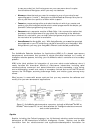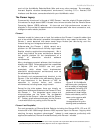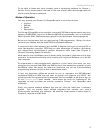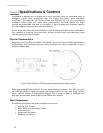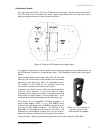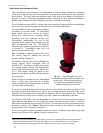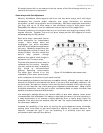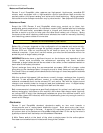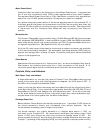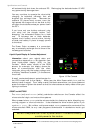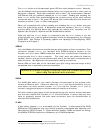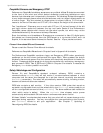
Specifications and Controls
Motors and Position Encoders
Pioneer 2 and PeopleBot drive systems use high-speed, high-torque, reversible-DC
motors, each equipped with a high-resolution optical quadrature shaft encoder for
precise position and speed sensing and advanced dead-reckoning. Motor gearhead
ratios and encoder ticks per revolution vary by robot model. See Appendix D for details.
Batteries and Power
Except the 2-CE, Pioneer 2 and PeopleBot robots may contain up to three, hot-
swappable, seven ampere-hour, 12 volts direct-current (VDC) sealed lead/acid batteries
(total of 252 watt-hours), accessible though a hinged and latched back door. We
provide a suction cup tool to help grab and slide each battery out of its bay. Spring
contacts on the robot’s battery power board alleviate the need for manually attaching
and detaching power cables or connectors.
Balance the batteries in your robot.
Battery life, of course, depends on the configuration of accessories and motor activity.
Pioneer 2-AT and PeopleBot charge life typically ranges from two to three hours. The
Pioneer 2-DX and -DXe run continuously for six hours or more; up to four hours with
onboard computer. If you don’t use the motors, your robot’s microcontroller will run for
several days on a single battery charge.
IMPORTANT: Batteries have a significant impact on the balance and operation of your
robot. Under most conditions, we recommend operating with three batteries.
Otherwise, a single battery should be mounted in the center, or two batteries inserted on
each side of the battery container.
Typical recharge time using the recommended accessory (800 mA) charger varies
according to the discharge state; it is roughly equal to three hours per volt per battery.
The Power Cube accessory allows simultaneous recharge of three swappable batteries
outside the robot.
With the optional high-speed (4A maximum current) charger, recharge time is greatly
reduced. It also supplies sufficient current to continuously operate the robot and
onboard accessories, such as the onboard PC and radios. But with the higher-current
charger, care must be taken to charge at least two batteries at once. A single battery
may overcharge and thereby damage both itself and the robot.
Both recommended chargers are specifically designed for optimal and safe lead-acid
battery recharging. Indicators on the module’s face show fast-charge mode (typically
an orange LED) in which the discharged batteries are given the maximal current, and
trickle mode (green LED indicator) which the batteries are given only enough current to
remain at full charge.
Electronics
Pioneer 2 and PeopleBot standard electronics reside on two main boards: a
microcontroller and a motor-power distribution board. Each sonar array also has a
controller board mounted in its base. A special I/O expansion board found inside the
left column strut of the Performance PeopleBot distributes User I/O for use by the robot’s
joystick port as well as it’s tabletop and breakbeam IR sensors.
A Main Power switch at the back of the robot controls power for the entire system.
Processor control switches and indicators fit through the Console.
14



